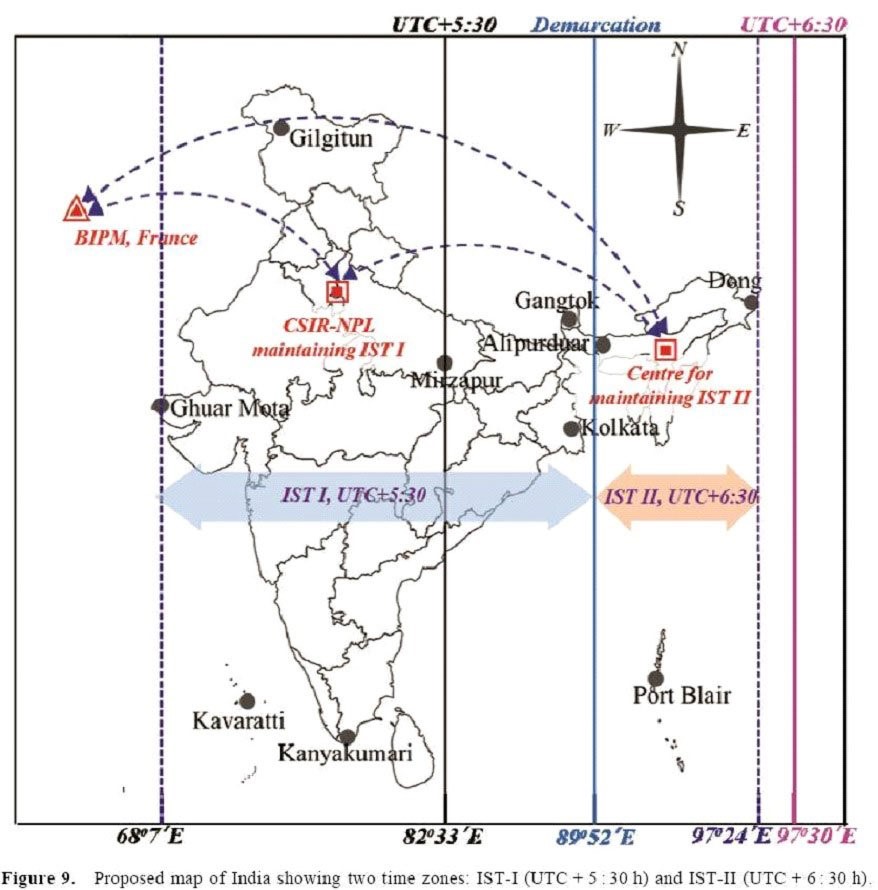[ad_1]

Context:
A favorite question of parliamentarians that has repeated, time after time, in every session of Parliament since 2002, is fittingly about time.
Cutting across party lines, members from both Houses have for two decades asked the Centre at least 16 times if India proposes to have two time zones and the steps taken to implement it.
First raised in March 2002, the question was effectively settled in August of that year.
A ‘High Level Committee’ (HLC) constituted by the Department of Science and Technology in that year had studied the issue and concluded that multiple zones could cause ‘difficulties’ that would disrupt the smooth functioning of the “airlines, Railways, radio, television and telephone services” and so it was best to continue with a unified time.
Research suggesting two time zones and two ISTs in India:
- India stretches nearly 3000 km from the east to the west. There are about 28 degrees of longitude between the country’s eastern and western extremities which results into approximately two hours’ time difference between the westernmost and the easternmost point.
- Indian Standard Time (calculated on the basis of 82.5′ E longitude, in Mirzapur, Uttar Pradesh), does not affect most of the Indians, except those who live in the Northeast region where the sun rises around 4 a.m. in summer, and gets dark well before 4 p.m. in winter.
- So, the Northeast region has long complained about the effect of a single time zone on their lives and their economies.
- Recently Council of Scientific & Industrial Research’s National Physical Laboratory (CSIR-NPL), which maintains Indian Standard Time (IST), published a research suggesting two time zones and two ISTs in India: IST-I for most of India and IST- II for the North-eastern region – separated by difference of one hour.
Early sunrise and sunset:
- The demand for two time zones rose because the northeastern India and the Andaman and Nicobar islands, because of their geography, see an early sunrise and sunset relative to the rest of the country.
- But because clocks didn’t account for this and official working hours being the same everywhere, valuable working hours were lost in the morning and unnecessary electricity was consumed in the evening hours in these regions and therefore, following a widely prevalent global practice — the U.S. has five time zones, Russia 11 — India too ought to have multiple ones, the reasoning goes.
- The expert committee, while not favouring multiple time zones, recommended that work timings in the eastern States be advanced by one hour, to “gainfully utilise” the morning hours and would involve only administrative instructions in this regard by the authorities concerned.
Benefits of two Time Zones:
- It will lead to greater efficiencies among the workforce and on energy consumption.
- Reduction in energy consumption will significantly cut down India’s carbon footprint boosting India’s resolve to fight climate change.
- There are economic benefits in having two different time zones as people will be able to work better and plan better, according to natural cycles.
- Many social policy objectives can be achieved such as reducing road accidents and improving women’s safety.
- Two time zones will allow aligning standard time with daylight time.
Problems of having two time zones:
- The possibilities of rail accidents would increase because of the two Time zones. Railway signals are not fully automated, and many routes have single tracks.
- Resetting clocks with each crossing of the time zone.
- The overlap between office timings reduces if there are two time zones. Important sectors like banks, industries and MNCs would face difficulties in adjusting to the new time zones.
- The marking of the dividing line of the two zones would be a problem.
- Two time zones can have adverse political consequences as India apart from getting divided on the lines of religion, caste, race, language, etc, now will get divided on the lines of Time Zones.
Productive hours of daylight:
The hours of daylight were when humans were most productive because specific proteins were expressed in those hours that governed blood pressure, temperature and reflexes, their studies had shown.
This was a compelling enough reason to have a separate time zone for the northeast, the NPL scientists wrote.
They also calculated that having two time zones would save 2,00,000 units of electricity annually and an issue raised, by the earlier committee, of potential train accidents could be solved if the time zone were set on the longitude passing through the West Bengal–Assam border where train inter–crossings were minimal.
Conclusion:
The need of the hour is to initiate a process of consultation to consider all aspects regarding the Indian time zone afresh.
Proposal of some researchers to set the IST forward by half an hour so that it is six hours ahead of Universal Coordinated Time can be examined and debated.
This will mean advancing the IST from 82.5 degree East to 90 degree East, which will fall at a longitude along the West Bengal-Assam border would go some way in meeting Assam’s demand, and help avoid potential grievances from northwestern India about corresponding inconveniences caused by advancing by one full hour.
[ad_2]

